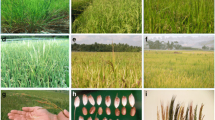Abstract
The Himalayan region is a known hot spot of crop diversity. Traditional varieties (usually called primitive cultivars or landraces), having withstood the rigors of time (including harsh climatic conditions as well as attacks of insects, pests and diseases), can still be found in crop fields in rural parts of Indian Central Himalaya (ICH). These landraces harbor many desired traits from which, for example, varieties that are tolerant/resistant to abiotic/biotic stresses could be developed. In addition to the above benefits, landraces provide a basis for food security and a more varied and interesting diet. Some landraces are also known to be of medicinal value. These, along with some lesser known hill crops, are often referred to by different names such as under exploited crops, crops for marginal lands, poor person crops, and neglected mountain crops. The Himalayan region continues to be a reservoir of a large number of landraces and cultivars whose economic and ecological potential is yet to be fully understood and/or exploited.
Indians have had a history of rice cultivation since ancient times. Farmers, including tribals inhabiting the IHR, still cultivate a plethora of landraces of rice and thus directly contribute towards on-farm conservation of valuable germplasm and help in the preservation of crop diversity. The present paper looks at the on-farm conservation of rice germplasm, which is still practised in the Kumaun region of ICH.
Similar content being viewed by others
References
Agnihotri R. K. 2002. Exploration and eco-physiological studies of various landraces of rice (Oryza sativa L.) in Kumaun Himalaya. Ph.D. thesis, Kumaun University, Nainital.
Agnihotri R. K., Palni L. M. S., Singh B. and Pangtey Y. P. S. 2003. Evaluation of fodder quality of straw of different landraces of rice (Oryza sativa L.) under cultivation in Kumaun region of Central Himalaya. International Journal of Sustainable Development and World Ecology 10(4): 391–400
Alteri M. A. and Merric L. C. 2002. In-situ conservation of crop genetic resources through maintenance of traditional farming system. Economic Botany 41: 86–96
Bawa K. S. 1993. Conservation of biodiversity in the Himalayas: concluding remarks and an agenda for action. In: Dhar, U (Ed.), Himalayan biodiversity: conservation strategies. Gyanodaya Prakashan, Nainital, pp. 529–538
Joshi S. C., Joshi D. R. and Joshi D. D. 1983. Kumaun Himalaya: A geographical perspective on resource development. Gyanodaya Prakashan, Nainital.
Kothari A. 1997. Conserving India’s Agro-biodiversity; Prospects & Policy Implementations. Gatekeepers Series No SA 65. Sustainable Agriculture Programme. London, U.K., pp. 1–8
Kulkarni D. K., Kumbhojkar M. S. and Khedkar R. 1998. Rice Germplasm Collection, Conservation and Use: A case Study in Western Maharashtra. Ethnobotany 10: 27–31.
Maikhuri R. K., Rao K. S., Semwal R. L. and Saxena K.G. 1998. State of under exploited mountain crops in the Indian Himalaya and erosion concerns. In: Pratap T, Sthapit B. (Eds), Managing Agrobiodiversity: Farmers changing perspective & Institutional responses in the Hidu Kush-Himalayan region. ICIMOD, Kathmandu, Nepal, pp. 241–253
Maikhuri R. K., Semwal R. L., Nautiyal S. Saxena K. G. 1997. Eroding traditional crop diversity imperiles the sustainability of agricultural system in the Central Himalaya. Current Science 73:777–782
Myers 1986. Biological resources of the tropics. In: Chopra V. L. and Khoshoo T. N. (eds.) Conservation for productive agriculture. Indian Committee for Agricultural Research, New Delhi.
Palni L. M. S. 1993. Conservation of plant genetic resources: the role of biotechnology. In: Himalayan biodiversity: conservation strategies. In: Dhar, U (ed.), Himalayan biodiversity: conservation strategies. Gyanodaya Prakashan, Nainital, pp. 481–496
Palni L. M. S. and Sharma S. 1999. Exploration, quantification and use of agricultural diversity and folk knowledge in a remote landscape of Central Himalaya. Final Technical Report, IIM, Ahemadabad, India.
Palni L. M. S., Sharma S., Joshi M. and Agnihotri R.K. 1998a. Agricultural Diversity in the Central Himalaya Using Diversity 2: 4–5
Palni L. M. S., Maikhuri R. K., Rao K. S. 1998b. Conservation of the Himalayan Agroecosystem: Issues and Priorities. In: Eco-regional cooperation for biodiversity conservation in the Himalaya. UNDP, New York, pp. 253–290.
Paroda R. S. 1997. Emerging concern for agrobiodiversity in the Indian national context: An introduction. Keynote address. Workshop on National Concern for Agrobiodiversity conservation, Management and Use. Oct 15–16, Shimla, India 15 pp.
Ramakrishnan P. S., Purohit A. N., Saxena K. G. and Rao K. S. 1994. Himalayan Environment and Sustainable Development. Diamond Jubilee Publication, INSA, New Delhi.
Riley K. W. 1996. Decentralized breeding and selection: tool to link diversity and development. In: Sperling, L and Loevinsohn, M. (Eds), Using Diversity: Enhancing and Maintaining Genetic Resources On-farm, IDRC, Scenario Publications, Noida, India, pp. 140–157.
Shiva V and Vanaja R. P. 1993. Cultivating diversity: Biodiversity conservation and seed policies. Research Foundation for Science Technology and Natural Resource Policy, Natraj Publishers, Dehradun. 130 p.
Swaminathan M. S. 1991. Sustainable agriculture system and food security. Outlook on Agriculture 20: 243–249.
Wolfe M. S. 2000. Crop Strength through Diversity. Nature 406: 681–682.
Wood D. and Linne J. M. 1997. The conservation of agrobiodiversity: questioning the emerging paradigm. Biodiversity and Conservation 6: 109–129.
Zhu Y., Chen H., Fan J., Wanj Y., Li Y., Chen J., Fan J., Yang S., Hus L., Leung H., Mew T. W., Teng P. S, Wang Z. and Mundt C. 2000. Genetic diversity and disease control in rice. Nature 406 718–722
Author information
Authors and Affiliations
Corresponding author
Rights and permissions
About this article
Cite this article
Agnihotri, R.K., Palni, L.M.S. On-farm conservation of landraces of rice (Oryza Sativa L.) through cultivation in the Kumaun region of Indian Central Himalaya. J. Mt. Sci. 4, 354–360 (2007). https://doi.org/10.1007/s11629-007-0354-3
Received:
Accepted:
Issue Date:
DOI: https://doi.org/10.1007/s11629-007-0354-3




